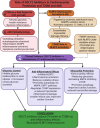Impact of sodium-glucose transport protein-2 (SGLT2) inhibitors on the inflammasome pathway in acute myocardial infarction in type 2 diabetes mellitus: a comprehensive review
- PMID: 40420176
- PMCID: PMC12105141
- DOI: 10.1186/s12933-025-02777-7
Impact of sodium-glucose transport protein-2 (SGLT2) inhibitors on the inflammasome pathway in acute myocardial infarction in type 2 diabetes mellitus: a comprehensive review
Abstract
Sodium-glucose transport protein-2 (SGLT2) inhibitors, initially developed for glycemic control in type 2 diabetes mellitus (T2DM), have emerged as potential cardioprotective agents, reducing cardiovascular mortality and improving heart failure outcomes. Recent evidence suggests that SGLT2 inhibitors exert anti-inflammatory effects, particularly through modulating the inflammasome pathway. This review explores the role of the inflammasome in acute myocardial infarction (AMI) in T2DM and discusses the mechanisms by which SGLT2 inhibitors influence this pathway. We evaluate current studies on the impact of SGLT2 inhibitors on key inflammatory mediators, particularly the NLRP3 inflammasome, and discuss their potential therapeutic implications for reducing inflammation and myocardial injury in patients with T2DM experiencing AMI. In summary, the key novelties in this review lie in its focused mechanistic approach on the inflammasome pathway, its integration of diabetes and cardiovascular research, and its potential to influence future therapeutic strategies for AMI in T2DM patients. It offers a novel angle by tying together molecular mechanisms of inflammation with clinical implications in a specific patient population that faces high cardiovascular risk.
Keywords: Diabetes; Inflammation; Myocardial infarction; Sodium–glucose transport protein-2 inhibitor.
© 2025. The Author(s).
Conflict of interest statement
Declarations. Competing interests: The authors declare no competing interests.
Figures
Similar articles
-
Inhibiting NLRP3 Inflammasome Activity in Acute Myocardial Infarction: A Review of Pharmacologic Agents and Clinical Outcomes.J Cardiovasc Pharmacol. 2019 Oct;74(4):297-305. doi: 10.1097/FJC.0000000000000701. J Cardiovasc Pharmacol. 2019. PMID: 31356538 Review.
-
NLRP3 Inflammasome in Acute Myocardial Infarction.J Cardiovasc Pharmacol. 2019 Sep;74(3):175-187. doi: 10.1097/FJC.0000000000000717. J Cardiovasc Pharmacol. 2019. PMID: 31356555 Review.
-
Combined SGLT2 and DPP4 Inhibition Reduces the Activation of the Nlrp3/ASC Inflammasome and Attenuates the Development of Diabetic Nephropathy in Mice with Type 2 Diabetes.Cardiovasc Drugs Ther. 2018 Apr;32(2):135-145. doi: 10.1007/s10557-018-6778-x. Cardiovasc Drugs Ther. 2018. PMID: 29508169
-
Cell-Specific Roles of NLRP3 Inflammasome in Myocardial Infarction.J Cardiovasc Pharmacol. 2019 Sep;74(3):188-193. doi: 10.1097/FJC.0000000000000709. J Cardiovasc Pharmacol. 2019. PMID: 31356542 Review.
-
The cardio-renal-metabolic role of the nod-like receptor protein-3 and senescence-associated secretory phenotype in early sodium/glucose cotransporter-2 inhibitor therapy in people with diabetes who have had a myocardial infarction.Diabet Med. 2025 Jul;42(7):e70059. doi: 10.1111/dme.70059. Epub 2025 Apr 25. Diabet Med. 2025. PMID: 40281683 Free PMC article. Clinical Trial.
References
-
- Lee YH, Kim SR, Bae J, Lee B, Kang ES, Ahn CW, et al. SGLT2 inhibitors suppress NLRP3 inflammasome activity via changes in ketones and insulin in type 2 diabetes and cardiovascular diseases. Diabetes. 2018. 10.2337/db18-164-OR.
Publication types
MeSH terms
Substances
LinkOut - more resources
Full Text Sources
Medical






